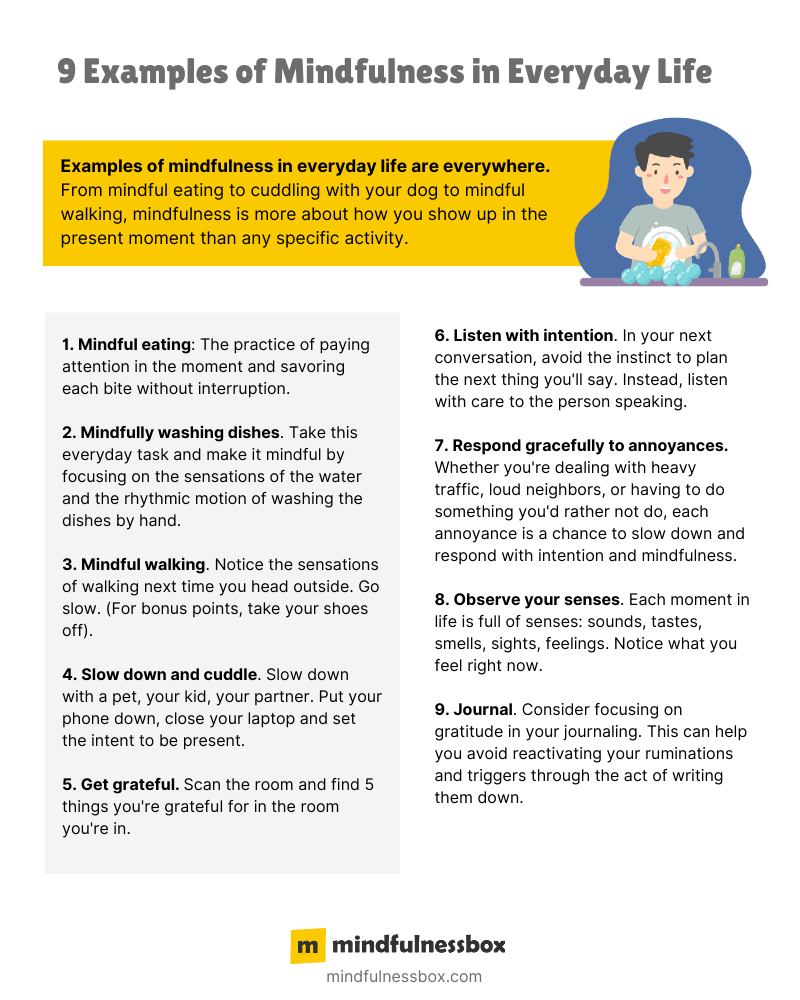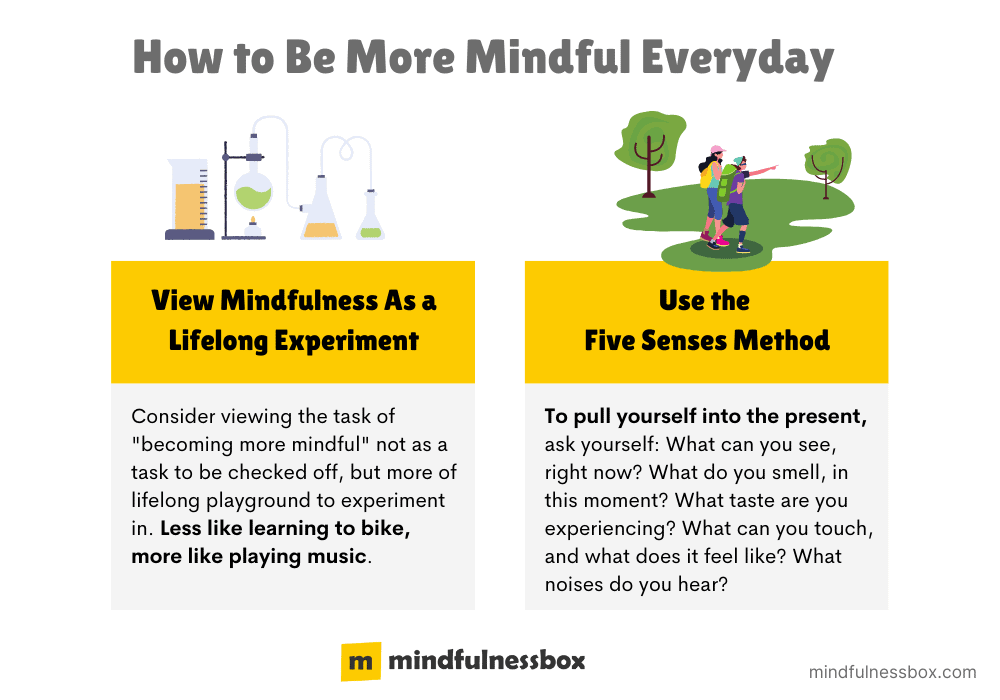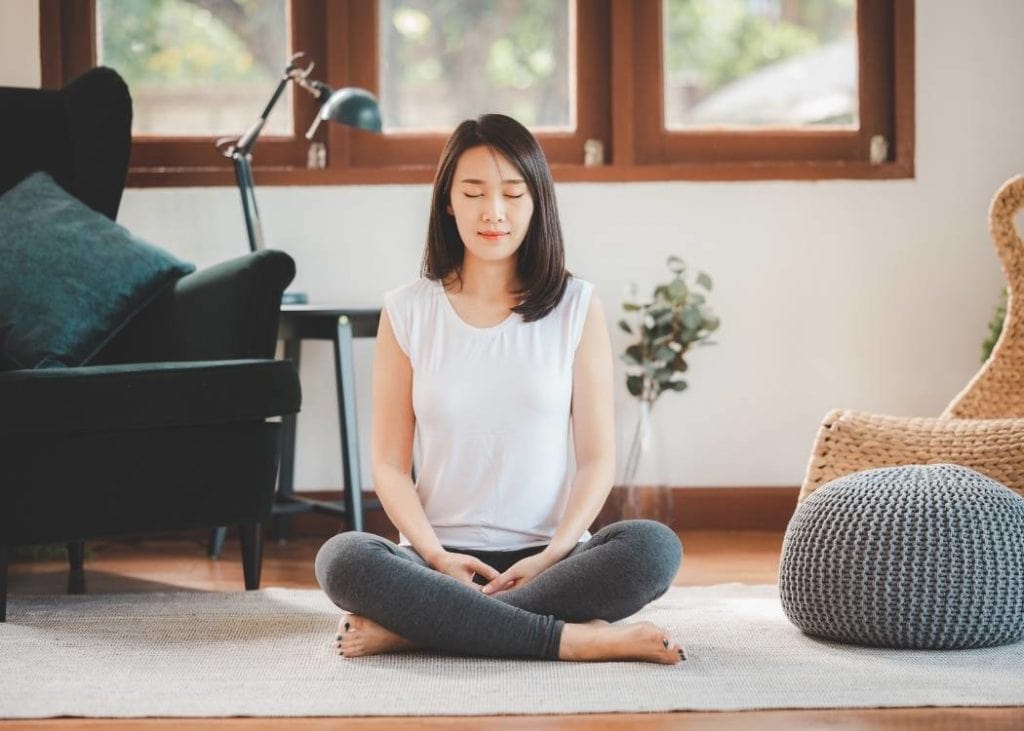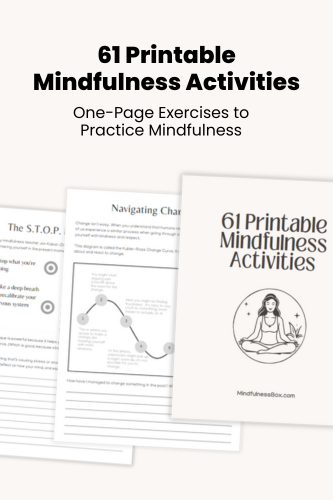Wondering how to experience mindfulness? Examples of mindfulness in everyday life are everywhere. Mindfulness isn’t just about meditation. From mindful eating to cuddling with your dog to mindful walking, mindfulness is more about how you show up in the present moment than any specific activity.
Most of us want to be more mindful, but common mindfulness techniques like meditation and yoga can require willpower and training. While meditation and yoga are helpful, the truth is that the purpose of both is to build your capacity to be mindful in everyday moments.
If you can skip straight to being mindful in your everyday life, you’ve already succeeded. By living life with intention, you can build the existence of greater peace that you’re striving for, and improve your day-to-day experience.
Get dozens of one-page exercises to help practice mindfulness, meditation, gratitude, and self love. Perfect for printable handouts when teaching mindfulness to groups, students, or in the workplace.
To see examples, plus a full list of the 61 exercises included, click below.
Examples of mindfulness in everyday life

Mindfulness is all around us, but do you know where to start?
Each day is filled with multiple opportunities to practice mindfulness. And they don’t all involve sitting on a meditation pillow.
Here are a few examples of mindfulness to get you started:
- Mindful eating: The practice of paying attention in the moment and savoring each bite without interruption. The raisin mindfulness exercise is a good example.
- Mindfully washing dishes after dinner: Take this everyday task and make it mindful by focusing on the sensations of the water and the rhythmic motion of washing the dishes by hand.
- Mindful walking: Notice the sensations of walking next time you head outside. (For bonus points, take your shoes off)
- Slow down and cuddle: Slow down with a pet, your kid, your partner. Put your phone down, close your laptop and set the intent to be present. Meditate with your dog.
- Get grateful: Scan the room and find 5 things you’re grateful for in the room you’re in
- Listen with intention: In your next conversation, avoid the instinct to plan the next thing you’ll say. Instead, listen with care to the person speaking
- Respond gracefully to annoyances: Whether you’re dealing with heavy traffic, loud neighbors, or having to do something you’d rather not do, each annoyance is a chance to slow down and respond with intention and mindfulness.
- Observe your senses: Each moment in life is full of senses: sounds, tastes, smells, sights, feelings. Notice what you feel right now. The weight of your body in the chair. The feeling of the air conditioning on your skin. The sound of the music you’re listening to, or wind moving through the trees outside.
- Journal: Consider focusing on gratitude in your journaling. This can help you avoid reactivating your ruminations and triggers through the act of writing them down.
What does it mean to live a mindful life?

To become more mindful means to be fully aware of the present moment, accepting what’s happening without judgement.
You might recall times when you’ve been in the middle of a task and suddenly realized that your mind was elsewhere; thinking about the past or present; or ruminating over a recent argument with someone. Not great, right?
When your mind is elsewhere, your day-to-day existence slips through your fingers. When you add up thousands of these moments, you’re left with years and years of cumulative moments lost.
Living a mindful life means incorporating this awareness into each day, and where possible, each moment. That’s where tools like meditation can come in – though meditation is not a goal unto itself, but a tool to train your mind to stop ruminating and come back to the present moment.
To take the art of living a mindful life a step further, you may want to (counterintuitively) zoom out from your present moment and look at your life as a whole.
Are your values aligned with the way you’re living your life? Are you feeling gratitude for the course your life has taken? Are you structuring your life in such a way that you have time for the introspection needed to build a calmer and more peaceful foundation for daily life?
How can I be more mindful?

So, you’ve decided we want to live a more mindful life, and understand what that means to you.
How do you actually experience mindfulness on a daily basis?
There’s no one answer. Plenty of people will offer you a single answer, but the honest truth is that just like with any skill, this is a lifelong journey.
You can’t expect to have the same amount of joy and peace in your daily life as the Dalai Lama or the late Desmond Tutu, who have decades and decades of mindfulness practice under their belts.
Instead, consider viewing the task of “becoming more mindful” not as a task to be checked off, but more of lifelong playground to experiment in. Less like learning to bike, more like playing music.
To quote the cliché, a journey of a thousand miles does begin with a single step. The easiest step to get started is to start building your habit of awareness. How are you feeling in each moment? Are you experiencing ruminating thoughts? How about in this very moment, as you’re reading this article?
A common trick for pulling yourself into the present during daily life is to use the five senses method: what can you see, right now? What do you smell, in this moment? What taste are you experiencing? What can you touch, and what does it feel like? What noises do you hear?
You may achieve clarity of thinking for one second, or ten, or sixty, before normal thought patterns draw you out of the present again. That’s okay.
Your next task is to build your attention muscle so your instinct for coming back to the present regularly gets stronger and stronger. There are many ways to do this, meditation being probably the most common.
When you know what coming back to the present feels like, and you’ve established a practice to strengthen that muscle, you’re on your way to experiencing more and more mindfulness in your daily life.
Can you be mindful all the time?

No! You simply can’t be mindful all the time. While it would be perfectly peaceful and mindful all the time, that expectation sets you up for disappointment.
Plus, a core tenet of mindfulness and meditation is nonjudgment. That means observing your thoughts as if they were clouds floating by, rather than a part of your identity to critique.
After you’ve let go of perfection and accepted that much (if not most) of your daily experience will still fail to be mindful, you can start appreciating how many opportunities you have each day for mindfulness.
Your life is already a walking mindfulness exercise.
In fact, as Leo Babauta of Zen Habits has observed, everything is a practice.
That means heavy traffic; annoying colleagues; noisy kids or pets; flight delays. Imagine how your life might transform if you built an “attention muscle” that helped you appreciate difficult moments because they reminded you to come back to the present and observe the feelings in your body and mind.
So no, you shouldn’t expect to be mindful all or most of the time, but as you find yourself drifting and notice it, appreciate it as a chance to come back to the present.
How can I become a more mindful person?

Don’t let the idea of “being more mindful” turn into a Herculean task that feels insurmountable.
Remember that becoming a more mindful person isn’t one decision: it’s thousands of decisions. Each time you journal, or meditate, or listen deeply to a friend, you’re casting a vote for the person you’ll be in the future.
So with that in mind, you might as well get a small win right now:
Start by paying attention to your breathing. Inhale deeply, then slowly let out the air as you near exhaling point. Be aware of how it feels when that happens.
Does your stomach feel tight? Are there any thoughts disrupting your attention? Note when they happen, and gently pull yourself back to the present moment without judgment.
It’s as easy, and as hard, as that.
Further reading
For more on mindfulness practices and becoming more mindful, check out the following articles:
- 33 Mindfulness Exercises for Present-Moment Living
- 9 Mindful Cooking Tips
- How to Be More Present (Starting Right Now)
- 7 Steps to Listen to Music Mindfully

My mindfulness practice kicked off in 2016 with a ten-day silent retreat. Since then, I’ve read dozens of books about mindfulness and completed hundreds of hours of meditation. Thinking about what makes humans happy, calm, and peaceful is endlessly fascinating to me.


